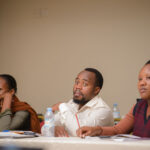This article was published more than 8 years ago.
Chloée Ponchelet is the Fund’s Program Officer for Migrants’ Rights, overseeing the Fund’s initiative to support activists that document and expose the grim reality facing migrants in transit, and advocate for improved migration policies.
This two-part series explores Chloée’s recent travel to Morocco, where she spent 48 hours with Fund grantee Caminando Fronteras — one of the only groups in the area working to document the exploitation, abuse, and trafficking of migrants at the Morocco-Spain border. Read part 1 here.
Two hours after Helena reached out to her friend with the Spanish coast guard, he called back and reported that he had spotted the dingy. Because of her call, a boat was now on its way to rescue the passengers in distress.
As we finally approached Nador in the car, Helena’s contacts were able to reach the families of those rescued, letting them know what they waited desperately to hear: all twenty-nine people were accounted for, all alive. In between Tangier and Nador, Caminando’s connections, expertise, and perseverance had saved lives from being taken by the sea. The power of Helena’s single phone call and quick action still strikes me today.
The missing boat wasn’t the only crisis handled during this trip. Five migrants had tried to jump over the fence surrounding the Spanish enclave of Ceuta the day before. While any individuals reaching Spanish soil should have the right to apply for asylum, Spanish authorities had returned the migrants to Moroccan authorities. As part of the authorities’ efforts to prevent migrants from staying near the border, these migrants were arrested and driven five hours away to Fes. It took only a couple of phone calls for Helena to learn that a minor was among the five sub-Saharans. Concerned for his health and safety – and interested in the possibility of challenging the treatment of a young migrant –the team decided to drive to Fes to investigate.
After the previous day’s eight-hour drive, the five hours it took to get to this interior city felt like a short trip. Again, Caminando’s team worked tirelessly to find these migrants in Fes. Around 10pm, we found them in a camp where others in similar situations had gathered. Helena’s reputation as a migrant advocate was enough to guarantee our security i, but the presence of dozens of curious people and the “chairman” of the community made it difficult for any conversation to remain confidential.
Seated on trunks around a feeble candle, using the light from a phone to take notes, Helena and her team kept the interview brief. They secured the return of the minor and the injured migrants to Tangier where Caminando could provide access to medical care and further document their story. Helena and her colleagues were hopeful they would have enough information to file a case at the European Union level.
The next morning, I parted ways with Helena and the group. I must admit the train to Melilla was boring compared to the rides I had just had.
As I sat in the train, I remembered Helena’s blank expression when I asked her how many lives she thought Caminando had saved through its tireless work. Her face indicated that she had never stopped to think about that question—and she was saved from answering by yet another phone call. This time, a potential victim of trafficking was desperately trying to reach her from an airport in Madrid; the young woman was looking for help as she was trying to secure protection. They would solve this case shortly on the road, too.
After four hours on the train, as I processed everything that had happened during the last two days, I answered my own question: Caminando’s team cannot afford to sit and count saved lives. There is always another phone call and another migrant who needs their help.


